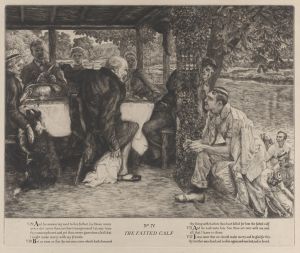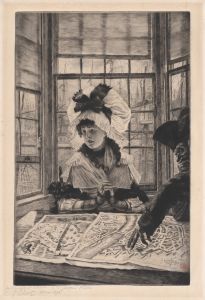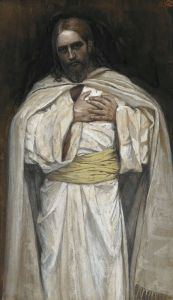
The departure of the prodigal son
A hand-painted replica of James Tissot’s masterpiece The departure of the prodigal son, meticulously crafted by professional artists to capture the true essence of the original. Each piece is created with museum-quality canvas and rare mineral pigments, carefully painted by experienced artists with delicate brushstrokes and rich, layered colors to perfectly recreate the texture of the original artwork. Unlike machine-printed reproductions, this hand-painted version brings the painting to life, infused with the artist’s emotions and skill in every stroke. Whether for personal collection or home decoration, it instantly elevates the artistic atmosphere of any space.
"The Departure of the Prodigal Son" is a painting by the French artist James Tissot, created in 1882. James Tissot, born Jacques Joseph Tissot on October 15, 1836, in Nantes, France, was known for his detailed and often narrative-driven works. He had a prolific career that spanned several decades and included both religious and secular themes.
This particular painting, "The Departure of the Prodigal Son," is part of Tissot's series of biblical illustrations. The work is inspired by the parable of the Prodigal Son from the Gospel of Luke in the New Testament. The parable tells the story of a younger son who asks his father for his share of the inheritance, leaves home, squanders his wealth in reckless living, and eventually returns home in repentance, where he is warmly welcomed by his forgiving father.
Tissot's interpretation of this moment captures the emotional and dramatic essence of the narrative. The painting depicts the moment when the younger son leaves his father's house. The composition is carefully arranged to highlight the tension and sorrow of the departure. The young man is shown in the center of the painting, dressed in fine clothes, indicating his readiness to embark on his journey. His father stands nearby, with an expression that conveys a mix of sadness and resignation. The background includes elements that suggest the wealth and stability of the household he is leaving behind.
Tissot's use of color and light in this painting is notable. He employs a warm palette to evoke the Mediterranean setting, with rich earth tones and soft lighting that enhance the emotional atmosphere. The attention to detail in the clothing and surroundings reflects Tissot's meticulous approach to his work, which often involved extensive research and preparation.
James Tissot's career included a significant period in England, where he moved in 1871 after the Franco-Prussian War. His time in London influenced his style and subject matter, leading to a series of successful exhibitions. Tissot returned to France in the early 1880s, and it was during this period that he began to focus more on religious themes, culminating in his ambitious project to illustrate the Bible.
"The Departure of the Prodigal Son" is part of Tissot's larger series of biblical illustrations, which were published in the form of a book titled "The Life of Our Lord Jesus Christ" in 1896. These illustrations were highly regarded for their historical accuracy and vivid storytelling, and they contributed to Tissot's reputation as a significant religious artist of his time.
The painting is currently housed in the Brooklyn Museum in New York, which holds a substantial collection of Tissot's works. The museum acquired the piece as part of its mission to preserve and showcase important works of art from various periods and regions.
In summary, "The Departure of the Prodigal Son" by James Tissot is a poignant and detailed depiction of a key moment from a well-known biblical parable. It reflects Tissot's skill as a narrative painter and his dedication to capturing the emotional and historical context of his subjects.















